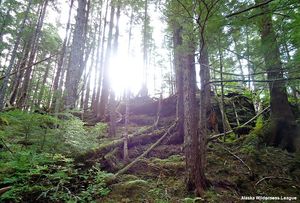Tongass National Forest
| KEY FACTS |
|
At 16.8 million acres, the Tongass National Forest is America’s largest national forest, encompassing the majority of the southeast Alaska panhandle. Each year more than 1 million people come to experience glaciers flowing from the mountains into the sea and iconic wildlife that thrives in one of the largest remaining temperate rainforests in the world.
Alaska’s national forests were protected under the 2001 Roadless Rule expressly because forested wildlands persist in Alaska on a scale unknown elsewhere in the country. In addition to harboring great natural beauty and iconic wildlife, scientists believe that retaining the intact roadless areas of the Tongass is a “key element” in sustaining the region’s extraordinary salmon runs (and its commercial, subsistence and recreational fisheries). Unfortunately, through legislation and regulatory rollbacks, the Alaska delegation and the current administration are attempting to exempt the Tongass from roadless protections.
Now the Trump administration is attempting to gut protections for the entire Tongass through an Alaska state-specific Roadless Rule. After a meeting between President Trump and Alaska Governor Dunleavy, the Secretary of Agriculture identified a preferred alternative in the draft Environmental Impact Statement for the rulemaking process which would exempt the entire state of Alaska from the Roadless Rule. This would open more than 9 million acres of roadless areas to roadbuilding activities and clear-cut logging of old-growth forest. In November, the House Natural Resources Committee held an oversight hearing focused on the impacts that removing roadless protections in the Tongass would have. Please see below for relevant legislation, talking points, fact sheets and more on what we're doing to defend the Tongass National Forest.
Fact Sheets | Congressional Letters | Public Letters | Maps | Research & Reports
Recent Legislative Activity
- H.R. 279/S. 877, Roadless Area Conservation Act (117th Congress)
- This bill would provide lasting protection for inventoried roadless areas within the National Forest System.
- To cosponsor, email Emma Reidy (mailto:emma.reidy@mail.house.gov) in Representative Gallego's office (D-AZ) or Amit Ronen (mailto:Amit_Ronen@cantwell.senate.gov) in Senator Cantwell's office (D-WA) for the Senate companion.
Talking Points
- Opening up the Tongass National Forest roadless areas to road building and logging threatens the abundant wildlife and beautiful scenery essential to the tourism and fishing industries in Southeast Alaska, each of which contributes approximately $1 billion dollars to the region’s economy each year.
- The Roadless Rule is the result of one of the most extensive public processes in U.S. history – more than 1.6 million people submitted comments on the rule, and 95% of those commented favorably on roadless protections.
- As part of the world's largest temperate rainforest, the Tongass stores a huge percent of the world's carbon — 8 percent of all forests in the Lower 48 combined. In total, the Tongass stores an estimated 1.5 billion metric tons of carbon and sequesters an additional 10 million metric tons annually. It makes no sense to subsidize the clearcutting of the United States' largest carbon sink at a time when the world and American communities are increasingly suffering from climate change impacts. When it comes to battling climate change, the Tongass National Forest is a life raft.
- The Roadless Rule rollback will ultimately cost taxpayers hundreds of millions of dollars. In total, the US Forest Service has lost approximately $600 million over the last twenty years or $30 million per year on average. Moreover, the USFS could end up losing more than $180 million in the Tongass over the next four years.
Fact Sheets
- Roadless Area Conservation Act
- The Roadless Rule Protects the Tongass National Forest
- What is the Roadless Rule?
- Taxpayers Subsidize the Clear-cut Logging of America’s Rainforest
- Know Your Salmon
Congressional Letters
- Letter from House and Senate Democrats to Secretary Perdue Opposing the FEIS for the Tongass Roadless Rule, October 2020
- Letter from Senate Democrats to Secretary Perdue on Environmental Justice and Opposing the DEIS Preferred Alternative for the Tongass Roadless Rule, December 2019
- Letter from House Democrats to Secretary Perdue Opposing the DEIS Preferred Alternative for the Tongass Roadless Rule, December 2019
- Letter from Senate Democrats to Secretary Perdue Opposing the DEIS Preferred Alternative for the Tongass Roadless Rule, November 2019
- Letter from House Democrats to Secretary Perdue Opposing Roadless Rule Rollbacks in Alaska, October 2018
- Letter from Senate Democrats to Secretary Perdue Opposing Roadless Rule Rollbacks in Alaska, October 2018
Public Letters
- Environmental Community Opposition Letter to USFS on Alaska State Specific Roadless Rule, October 2018
- Letter from Scientists to the USFS Supporting Roadless Rule Protection in the Tongass, September 2018
- Environmental Community Opposition Letter to Alaska Native Claims Settlement Improvement Act (S. 1481), January 2018
Maps
- Tongass National Forest Roadless Areas
- The Tongass 77 Priority Salmon Watersheds
- National Forests of Alaska - USFS
Research & Reports
- Cutting Our Losses after 40 Years of Money-Losing Timber Sales in the Tongass - Taxpayers for Common Sense, September 2020
- Trump’s Energy Policies Put Alaska in the Climate Crosshairs - Center for American Progress, November 2019
- Cutting Our Losses: 20 Years of Money-Losing Timber Sales in the Tongass - Taxpayers for Common Sense, October 2019
